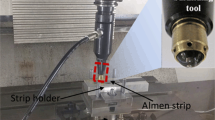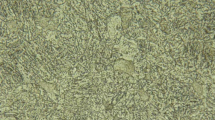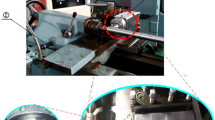Abstract
Mechanical and metallurgical characteristics of the surface layers are modified as the material is subjected to the burnishing process. Plastic deformation is known as a major reason for property enhancement of the surface and subsurface layers. Residual stress distribution and influenced depth of plastic deformation provide useful information regarding the functionality and life cycles of the burnished sample. In the present study, a novel analytical approach was presented to predict residual stress distribution and the depth of plastic defamation in the ultrasonic-assisted ball burnishing process. The burnishing process was firstly analyzed using the contact mechanic of an elastic sphere with semi-infinite body theorem. Then, the plastic deformation and residual stress were modeled using the McDowell algorithm. The model could incorporate effects of vibration amplitude and frequency, static pressure, feed rate, and ball dimensions. A series of ultrasonic-assisted ball burnishing experiments have been carried out on aluminum 6061-T6 and AISI 1045 steel to confirm the proposed model prediction results. The prediction accuracy of the proposed model was further verified by residual stress distributions of AISI 304, Ti-6Al-4V, and Inconel 718 from other literatures. The research findings in this study indicated that the developed model could be used for a variety of engineering materials in the prediction of residual stress with adequate precision.


















Similar content being viewed by others
References
Amini S, Bagheri A, Teimouri R (2018) Ultrasonic-assisted ball burnishing of aluminum 6061 and AISI 1045 steel. Mater Manuf Process 33(11):1250–1259
Liu Z, Dai Q, Deng J, Zhang Y, Ji V (2020 Apr) Analytical modeling and experimental verification of surface roughness in the ultrasonic-assisted ball burnishing of shaft targets. Int J Adv Manuf Technol 1:1–21
Zhao J, Liu Z (2016) Investigations of ultrasonic frequency effects on surface deformation in rotary ultrasonic roller burnishing Ti-6Al-4V. Mater Des 107:238–249
Sidhu KS, Shi J, Vasudevan VK, Mannava SR (2017) Residual stress enhancement in 3D printed Inconel 718 superalloy treated by ultrasonic nano-crystal surface modification. In: ASME 2017, the 12th International Manufacturing Science and Engineering Conference collocated with the JSME/ASME 2017 6th International Conference on Materials and Processing. American Society of Mechanical Engineers Digital Collection
Ting W, Dongpo W, Gang L, Baoming G, Ningxia S (2008) Investigations on the nanocrystallization of 40Cr using ultrasonic surface rolling processing. Appl Surf Sci 255(5):1824–1829
Cherif A, Pyoun Y, Scholtes B (2010) Effects of ultrasonic nanocrystal surface modification (UNSM) on residual stress state and fatigue strength of AISI 304. J Mater Eng Perform 19(2):282–286
Huuki J, Laakso SV (2013) Integrity of surfaces finished with ultrasonic burnishing. Proc Inst Mech Eng B J Eng Manuf 227(1):45–53
Travieso-Rodriguez JA, Gomez-Gras G, Dessein G, Carrillo F, Alexis J, Jorba-Peiro J, Aubazac N (2015) Effects of a ball-burnishing process assisted by vibrations in G10380 steel specimens. Int J Adv Manuf Technol 81(9-12):1757–1765
Ye C, Telang A, Gill A, Wen X, Mannava SR, Qian D, Vasudevan VK (2018) Effects of ultrasonic nanocrystal surface modification on the residual stress, microstructure, and corrosion resistance of 304 stainless steel welds. Metall Mater Trans A 49(3):972–978
Teimouri R, Amini S, Bami AB (2018) Evaluation of optimized surface properties and residual stress in ultrasonic assisted ball burnishing of AA6061-T6. Measurement. 116:129–139
Liu Y, Wang L, Wang D (2011) Finite element modeling of ultrasonic surface rolling process. J Mater Process Technol 211(12):2106–2113
Liu Y, Zhao X, Wang D (2014) Effective FE model to predict surface layer characteristics of ultrasonic surface rolling with experimental validation. Mater Sci Technol 30(6):627–636
Khan MK, Fitzpatrick ME, Wang QY, Pyoun YS, Amanov A (2018) Effect of ultrasonic nanocrystal surface modification on residual stress and fatigue cracking in engineering alloys. Fatigue Fract Eng Mater Struct 41(4):844–855
Liu Z, Yang M, Deng J, Zhang M, Dai Q (2020) A predictive approach to investigating effects of ultrasonic-assisted burnishing process on surface performances of shaft targets. Int J Adv Manuf Technol 106(9):4203–4219
Shen X, Gong X, Zhang J, Su G (2019) An investigation of stress condition in vibration-assisted burnishing. Int J Adv Manuf Technol 105(1-4):1189–1207
Teimouri R, Amini S (2019) Analytical modeling of ultrasonic surface burnishing process: evaluation of through depth localized strain. Int J Mech Sci 151:118–132
Teimouri R, Amini S, Guagliano M (2019) Analytical modeling of ultrasonic surface burnishing process: evaluation of residual stress field distribution and strip deflection. Mater Sci Eng A 747:208–224
Hua Y, Liu Z, Wang B, Jiang J (2019) Residual stress regenerated on low plasticity burnished Inconel 718 surface after initial turning process. J Manuf Sci Eng 141(12)
Johnson KL, Johnson KL (1987) Contact mechanics. Cambridge university press
Popov VL (2010) Contact mechanics and friction. Springer Berlin Heidelberg, Berlin
Hu Y, Yao Z, Hu J (2009) An analytical model to predict residual stress field induced by laser shock peening. J Manuf Sci Eng 131(3)
McDowell DL (1997) An approximate algorithm for elastic-plastic two-dimensional rolling/sliding contact. Wear. 211(2):237–246
Qi Z, Li B, Xiong L (2014) An improved algorithm for McDowell’s analytical model of residual stress. Front Mech Eng 9(2):150–155
Zhang W, Wang X, Hu Y, Wang S (2018) Predictive modelling of microstructure changes, micro-hardness and residual stress in machining of 304 austenitic stainless steel. Int J Mach Tools Manuf 130:36–48
Lazoglu I, Ulutan D, Alaca BE, Engin S, Kaftanoglu B (2008) An enhanced analytical model for residual stress prediction in machining. CIRP Ann 57(1):81–84
Yang D, Liu Z (2015) Surface plastic deformation and surface topography prediction in peripheral milling with variable pitch end mill. Int J Mach Tools Manuf 91:43–53
Liang X, Liu Z, Wang B, Hou X (2018) Modeling of plastic deformation induced by thermo-mechanical stresses considering tool flank wear in high-speed machining Ti-6Al-4V. Int J Mech Sci 140:1–12
Murugesan M, Jung DW (2019) Johnson cook material and failure model parameters estimation of AISI-1045 medium carbon steel for metal forming applications. Materials 12(4):609
Kolasangiani K, Shariati M, Farhangdoost K, Varvani-Farahani A (2017) Numerical and experimental study on ratcheting behavior of plates with circular cutouts under cyclic axial loading. J Solid Mech 9(4):811–820
Pyoun YS, Park JH, Suh CM, Amanov A, Kim JH (2011) Friction and wear characteristics of SUS304 and SUS630 after ultrasonic nanocrystal surface modification. Adv Mater Res 275:174–177
Amanov A, Cho IS, Kim DE, Pyun YS (2012) Fretting wear and friction reduction of CP titanium and Ti–6Al–4 V alloy by ultrasonic nanocrystalline surface modification. Surf Coat Technol 207:135–142
Gill A, Telang A, Mannava SR, Qian D, Pyoun YS, Soyama H, Vasudevan VK (2013) Comparison of mechanisms of advanced mechanical surface treatments in nickel-based superalloy. Mater Sci Eng A 576:346–355
Teimouri R, Amini S, Ashrafi H (2019) An analytical model of burnishing forces using slab method. Proc Inst Mech Eng E J Process Mech Eng 233(3):630–642
Acknowledgments
The authors would like to acknowledge the financial support from the National Key Research and Development Program of China (2019YFB2005401). This work was also supported by grants from Taishan Scholar Foundation and Shandong Provincial Natural Science Foundation of China (ZR2019MEE073).
Author information
Authors and Affiliations
Corresponding author
Additional information
Publisher’s note
Springer Nature remains neutral with regard to jurisdictional claims in published maps and institutional affiliations.
Appendices
Appendix 1. Calculation of maximum static and dynamic contact pressure
1.1 Analysis of loading
Static load
Based on Hertizan contact mechanic problems, contact or impact of two spheres is a general form of the contact between a sphere and flat surface. While the radius of one sphere tends to be infinite, the model would be identical. Considering the ball as rigid material and infinter radius of flat surface, the total displacement through radius (as shown in Fig. 19) is determined:
where Uz(r) is radius-dependent axial displacement, δ is the maximum displacement in the contact center, and R is the radius of the sphere.
In the above equation, uz(r) is the vertical displacement of the ball in sheet material in radial direction, δ is the displacement of the ball in the sheet at the center of contact, and R is the ball diameter.
Using Hertz contact, the radius-dependent pressure distribution and pressure-dependent displacement can be obtained as [16]
where P(r) is through radius pressure distribution, P0 is the maximum pressure at contact midpoint, and re is the maximum elastic radius. Eeq is the equivalent Young modulus of ball and work material that depends on the Young modulus of the workpiece and ball (i.e., E1 and E2) as well their Poisson ratio (ϑ1 and ϑ2).
Considering Eqs. 39 and 37 as identical, some geometrical characteristics of contact are identified. The boundary condition is that the displacement in the maximum elastic radius is zero. (r = re → Uz(r) = 0).
Considering the circular shape of the contact, the applied force which leads to pressure distribution is obtained by
By substituting Eq. 42 in 44 and elimination of re, the relationship for obtaining maximum pressure as a result of static force is obtained.
Dynamic load
The dynamic load in ultrasonic-assisted burnishing is due to high-frequency vibration of the tool which is exerted on the surface. The displacement and velocity of the tool as a result of ultrasonic oscillation are obtained by
where X and V are the displacement and velocity, respectively. Also, vibration amplitude and frequency are denoted by A and f, respectively.
During the ultrasonic-assisted burnishing, the impact of the vibratory ball and the surface of the sample occurs when the velocity is maximum, i.e., Vmax = 2πAf.
By writing work and energy principle, the displacement as a result of dynamic load is obtained.
where D is the ball diameter and ρ is the ball density.
The relationship between maximum contact pressure, maximum contact radius, and maximum contact depth which were used for static load can be used for dynamic load. This by substituting Eq. 47 into Eq. 41 to 43, the pressure, radius, and depth as a result of dynamic load are also established.
Appendix 2. Identifying principal strains
The principal strains are the roots of cubic equations as follows:
where the I1, I2, and I3 are the stress invariants which are calculated by the following equations:
According to the plane strain condition, the constant values are modified as follows:
Schematic illustration of elastic contact of two spheres including geometrical characteristics [16]
Rights and permissions
About this article
Cite this article
Teimouri, R., Liu, Z. An analytical prediction model for residual stress distribution and plastic deformation depth in ultrasonic-assisted single ball burnishing process. Int J Adv Manuf Technol 111, 127–147 (2020). https://doi.org/10.1007/s00170-020-06068-1
Received:
Accepted:
Published:
Issue Date:
DOI: https://doi.org/10.1007/s00170-020-06068-1





